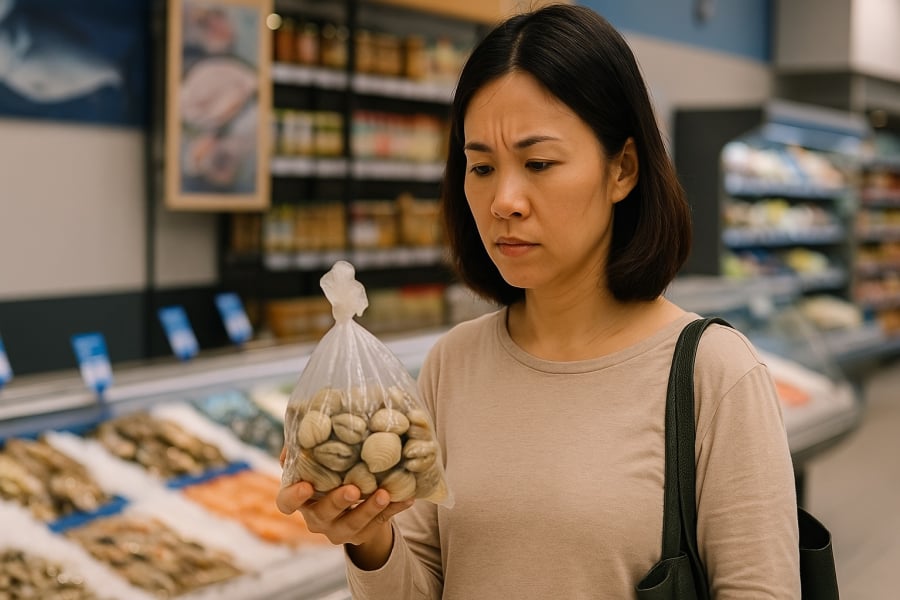Seafood Bleaching: The Hidden Danger Behind the Glossy Shell
Many consumers are deceived by the attractive appearance of seafood on market shelves: snow-white shrimp, crystal-clear squid, and mud-free clams. Few are aware that to maintain the “freshness” longer or make the products more appealing, some vendors use industrial chemicals such as hydrogen peroxide, formalin, or sulfite bleaching agents.
According to PGS. TS Nguyen Duy Thinh from the Institute of Biotechnology and Food Technology at Hanoi University of Technology, as quoted in VnExpress: “These chemicals can cause liver and kidney damage and even cancer if accumulated in the body over time.”
Worryingly, many consumers lack the knowledge to distinguish between clean seafood and seafood that has been treated with chemicals.
Black Tiger Shrimp – From Black to Pristine White
Shrimp is one of the most commonly “bleached” types of seafood. Natural Black Tiger shrimp usually have a slightly discolored shell with spots or a slightly black head. However, many people believe that the whiter the shrimp, the fresher it is. This is where unscrupulous sellers can easily deceive buyers.
To make the shrimp whiter, sellers may soak them in hydrogen peroxide (hydrogen peroxide) or sulfite solution, causing the shrimp to lose their natural color and appear more appealing.
How to identify bleached shrimp:
- Shrimp are abnormally white, shiny, and uniformly colored.
- The head easily falls off, and the body is soft and lacks elasticity.

Squid – Crystal Clear but Hiding a Toxic Secret
Squid is a familiar victim of bleaching practices as it easily discolors when left out for too long. To maintain its bright white appearance, sellers often soak the squid in limewater, hydrogen peroxide, or industrial bleaching agents.
According to information from ZingNews, medical experts warn that these substances can cause digestive irritation and potentially cell mutations if consumed over extended periods.
Warning signs to look out for:
- The squid is abnormally white and shiny, with an unnatural slippery texture and a lack of natural mucus.
- When cut open, it doesn’t have the characteristic fishy smell but instead emits a strange, pungent odor.
Clams – Unnaturally White and Clean
Natural clams usually have slightly dirty shells with some mud attached, especially after harvesting. But if you come across clams that are unusually white, with spotlessly clean shells and even a faint pleasant odor, they have likely been soaked in bleaching chemicals.
Many people mistakenly believe that clean clams are simply well-washed, but in reality, many processing facilities use bleaching agents such as chlorine or formalin to “polish” the clams before bringing them to market.
Indicators of bleached clams:
- Clam shells are uniformly white and abnormally smooth and shiny.
- When boiled, the cooking water becomes cloudy and emits a strange odor.

Octopus – The Whiter, the More Dangerous
Fresh octopus usually has a light gray or slightly cloudy color, with a soft body and slight ink marks. If you come across octopus that is as white as powder, it has likely been treated with sulfites or other bleaching agents.
According to Doctor Tran Ngoc Luu Phuong from Nguyen Tri Phuong Hospital, as quoted in Dan Tri: “Substances like sodium sulfite, when used in excessive doses, can damage the gastric mucosa and pose risks to the liver, kidneys, and the possibility of cancer if consumed over the long term.”
Dried Fish – Bleached to Look ‘Newly Sun-Dried’
It’s not just fresh seafood that falls victim to bleaching practices; dried fish is also treated with chemicals to hide signs of aging, mold, or spoilage. Fish that has been sun-dried multiple times or previously frozen is soaked in sulfite or chlorine solutions to make it look fresh and glossy.
Warning signs to avoid:
- Dried fish that is abnormally white and emits a strong chemical odor.
- Lacks the subtle natural fishy smell of seawater-caught fish.
How to Protect Yourself and Your Family
- Choose reputable sources: Prioritize purchasing seafood from familiar shops with clear origins or from large supermarket chains.
- Self-processing: Opt for live or unprocessed seafood and perform the cleaning and preparation yourself at home.
- Observe color, texture, and odor: Unusual appearances such as excessive whiteness, strange odors, and soft textures are red flags.
- Be cautious of unusually low prices: High-quality, fresh seafood is never cheap. If the price seems too good to be true, there’s likely a hidden catch.
In Conclusion
A family meal is not just about gathering together but also about nurturing the health of your loved ones. Don’t let a lack of knowledge compromise the well-being of yourself and those dear to you.
Seafood is a gift from the sea – choose wisely to honor its true value.






























